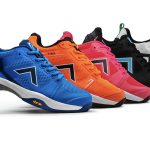Backcounty ski was by far the biggest category at the Backcountry Base Camp at Snowbasin as ski, boot, binding and safety equipment vendors displayed their ever growing product lines. Vendors seemed to be catering to a sport that is growing both up and down; toward the extremes and toward the middle. As a result, their marketing messages sometimes seemed schizophrenic. On one hand, they spoke about versatility a single ski or boot designed to climb, tour and bomb downhill over multiple types of terrain and snow. On the other hand they continued adding new flavors for niche markets.
Ski and boot companies are clearly eyeing the growing number of skiers that are choosing to telemark on groomed resort slopes rather than the backcountry, while also trying to keep hardcore heli and freeride fanatics happy. This has them broadening their product lines to cater to a widening array of preferences for speed, stiffness, flotation, stability, weight and versatility. Notable new wrinkles included boots that can be quickly adjusted for walking, touring or downhill skiing; wider, upturned or rockered tips to easy skiing in powder; broader product offerings for women; and an early nod toward the use of sustainable materials in skis.
The Swiss company Movement added the Yaka Jam to its free-ski family. The ski features a wide shovel for unparalleled float in deep snow and enough side cut to grab hard and icy groomed trails.
Karhu stressed its sustainability story, which revolves around replacing metal in the core of its skis with rapidly growing woods that absorb a lot of carbon. The company is using its so-called Greenlight Cores – introduced last year in its Storm BC, Spire BC, its full line of women's series, and its SCD Backcountry skis for 2008. The lighter weight makes these skis easier to turn in powder. Karhu also introduced the Widetrack family of XC skis that play to growing demand for one-day family adventures. Karhu says the skis greatly simplify XC skiing. Because they are shorter and wider, the skis are more stable and easier to maneuver. And, since they come in only three sizes, they are easier to buy.
Atomic introduced the Alea 53, a new, lighter Nordic ski for women using its Helium Tube Core technology and G2 waxless pattern, which features separate grip and glide zones on the base to ease gliding. Like Black Diamond, Atomic incorporated Boa technology in a new boot, the Boa Skate. Atomic also added rocker to the tips of its Big Daddy skis to make them float better and prevent tip dive.
K2 introduced a new telemark/AT collection with skis for big mountain freeriders, telemarkers and AT. For freeriders, K2 introduced the SODO, its heaviest and stiffest backcountry ski featuring menacing, dark industrial graphics. The Coomba ski, named for the deceased mountaineer who designed them, is optimized for deep bowl skiing. In the telemark category, K2 introduced the Anti Piste – French for “anti-trail” – featuring a mini-rocker in the shovel, or nose, of the ski designed to lift it over powder much the same way a water ski or kayak is rockered to lift its leading tip out of the water. K2 claims this design makes it much easier and less tiring to ski powder than with conventionally cambered skis presumably an important feature at a time when less expert skiers are taking up telemark.
K2 also redesigned the graphics on its women's line, the Dawn Patrol and Schi Devil. In AT, K2 introduced the Miss Baker, a women's version of a light ski designed for touring in deep or heavy snow conditions. The bright yellow skis – adorned with graphics reminiscent of a Pacific Northwest Indian tribe – feature holes in the tips so they can be converted easily and quickly into a sled for emergency evacuation.
Garmont introduced a new line of three-buckle boots designed by well-known backcountry skier and author Paul Parker. With the new Radium, Argon and Helium, Parker has substituted an overlap shell and cuff for a conventional tongue in an effort to provide a boot that is better for walking, climbing and skiing. The boots are designed to hold the instep and foot secured to the boot even as the skier flexes forward to bomb downhill. All boots come standard with thermoformed liners that have their own lacing system and use silver fiber to retain heat and repel microbes and odor. The liners feature double loops and lycra on the rear to ease entry. Garmont also showed off a line of shovels, probes and poles from Life-Link, a company it acquired in July. Included: three all-season, telescoping poles for women featuring smaller grips that can be quickly converted into avalanche probes.
Scarpa introduced three new freeride/AT boots that work with Dynafit bindings: the Typhoon for men, the Domina for women, and the heavy-duty Skookum for big skis. Made using dual-injection molding, the boots are “ideal for the skier that needs a super rigid boot for aggressive terrain yet wants the versatility to put it in walk mode for that quick boot up the ridge or the tour to reach a steep descent.” They are built with 100% Pebax, which while light weight, retains stiffness over a broad range of temperatures. The boots feature a Velcro power strap to lock down the boots after they've been buckled. They also feature a hinged tongue for touring that can be swapped out for a ski tongue that is 20% stiffer for downhill skiing. The boots come with Intuition Speed Pro liners that can be remolded many more times than earlier versions.
Scarpa also added the Terminator X Pro, a heartier version of a boot introduced last year that works with both Rottefella's NTN telemark bindings and Dynafit's AT bindings. The four-buckle Terminator X Pro is made to drive the bigger skis used by hardcore freeriders. Scarpa uses triple injection molding on the Terminator X series so that the bellows toward the toe flex for telemarking, even as the rest of the boot remains rigid. The Terminator X family uses Garmont's unique second heel binding for free heel bindings.
Black Diamond introduced nine boots in three categories: AT Power (3), AT Efficiency (3) and Telemark Efficiency (3). The collection includes a womens boot in each category. The Power Series are beefier boots that provide freeriders the rigidity they need for serious downhill and hucking, while the Efficiency Series focuses more on the freedom of movement and lower weight favored for climbing the slopes and traversing terrain to access backcountry. BD uses triple injection molding so that the resistance of the shell progresses as the skier leans forward. The boots soles can be swapped out to work with either telemark or alpine bindings and the top of the line boots feature the Boa cable lacing system already in use among snowboarders and Nordic skiers so that skiers can literally dial in tightness without messing with their buckles. The top-of-the-line boot in the Power series, the Factor, will retail for $699, including a liner and an integrated boot board, or insole, that can be ground to a custom fit by dealers.
“This whole outdoor versus alpine thing is dissolving,” said Roch Horton, a BD product designer. “As far as AT and Freeride, alpine shops are beginning to see this is a place where they can play. Ski mountaineering is marrying alpine and they are becoming one. A lot of telemarkers are gong to freeride to extend their careers.” BD considers the new lines a new category of boot that fills the gap between alpine and touring boots. The lines target hardcore freeriders, many of whom are still accessing the backcountry with AT boots before switching to alpine boots for their descent.
Backcountry Access, which already controls 70% of the U.S. market for avalanche beacons, raised the bar with its $335 Tracker 2, which is easier to put in search mode. To activate BCAs original Tracker DTS transceiver, users must press a button for between one and two seconds to avoid false triggers. The Tracker 2 replaces the button with a tab at the bottom of the unit that must be pulled down.
On the technology front, the Millennial generation's obsession with iPods, digital cameras and the Internet continued to drive design whether it was Smith Optic's ski helmets embedded with Bluetooth controls, GoPro's helmet-mounted video cameras or gloves made by 180s that incorporate special fabrics in the finger and thumb tips that allow users to manipulate their iPods.
Among the more compelling stories was that presented by National Geographic, which thinks it has removed a major obstacle to wider use of handheld GPS units. While sales of such units have grown dramatically since their introduction 14 years ago, their adoption is still hindered by a lack of easy-to-access, up-to-date trail information. To address this issue and sell more of its own maps, National Geographic will launch the Website TOPO! Explorer in May. Dubbed the “YouTube of Trails and Maps” by one NG executive, the new Website will present users with detailed topographical maps, aerial photography, a hybrid map made from the two, and an extensive, freely browsable, online database of trail descriptions, recommendations and unique points of interest. Each trail description will appear as a push pin on a U.S. map, which users can search using a series of filters, such as hunting units, portage sites, day hikes, etc. At launch, the TOPO! Explorer website – www.topo.com – will contain thousands of unique files provided by government agencies, regional trail and access clubs, publishing partners and National Geographic. Users will be encouraged to review posted trip files and share their own files using an integrated publish-to-site feature as a component of a larger social networking portion of TOPO! People will be able to access the site for free and search for hunting units, portage locations, day hikes and other trips using a series of filters. They only pay when they want to print maps or transfer maps to their GPS. Cost: $1 per download. NG will begin shipping two versions of TOPO! Explorer software in May for downloading routes from the Web site. For $24.95, users get 25 map download credits they can redeem online. For $49.95, they get a 2-CD set that provides the first five of seven zoom levels up to the 1:100,000 scale and 25 online credits.
Magellan hopes to leverage the TOPO! Explorer launch to boost sales of its new Triton series of handheld GPS units, which it began shipping this month. The color touch-screen Tritons are the only handheld GPS units on the market that can download National Geographic's USGS topographical maps for use in the field. Until now, GPS users could not load raster, or image, maps to their handheld units. They could plot a course between waypoints, but could not view the same detailed topographical images on their handhelds as National Geographic software displayed on their computers. That means users could not see details, like gradients, in the field that might cause them to alter their route. Triton users, however, can view maps on a 1:24,000 scale, or four times what was previously available. The top-of-the-line Triton 1500 and 2000 also have microphones and speakers that allow users to link audio recordings to waypoints. The Triton 2000 features a digital camera that allows the user to also link images with waypoints. This effectively allows users to create and share multimedia files that can be used as virtual guides.
The Austrian company Komperdell had one of the more compelling innovations at the show. Its Snaplock trekking pole features a trigger control in the handle that allows hikers to adjust its height with the flick of a finger. This eliminates the need to stop, unfasten the pole and adjust its height, which can become a nuisance in rapidly changing terrain. The company is offering the pole for $229.95 and contemplating introducing a carbon version sheathed in bamboo in the United States for $249.95.
Native Eyewear made an impressive debut into ski goggles with its “lockjaw technology.” The company is offering the Mission for medium-sized faces and the squarer looking Siege for larger faces. Both feature a polarized, double spherical lens that traps air between two lenses to prevent fogging. The lenses have anti fogging coating on the inside and anti-scratch coating on the outside. The lockjaw mechanism, which is reminiscent of a trap when opened, is incorporated into the triangular nose bridge and can be popped open easily to swap out lenses. Native and Julbo both introduced chunkier versions of their sport and lifestyle sunglasses featuring the fat temple look favored by the West Coast surf crowd.
Smith Optics pushed helmet design forward through better integration with both audio and optics. Using Bluetooth technology, Smith has created the Skullcandy Bluetooth Wireless Audio System, a set of transponders that convert sound into a low-strength radio signal that can travel about 10 meters. Each system includes seamlessly integrated high fidelity speakers and drivers in the ear pads, which feature glove friendly volume and mute controls. The systems also have a universal adaptor that turns any mp3 player or iPod into a Bluetooth device. All Bluetooth enabled cell phones will seamlessly synch with the Skullcandy system, offering up to 10 hours of battery life. Skullcandy will be available in five of Smith's top-of-the-line helmets priced from $240-$320. Smith also introduced AirEvac helmets, which are designed to actively vent heat and moisture from Smith goggles through specially designed vents and channels. Helmet brims often block carefully designed goggle vents. Finally, Smith incorporated two quick release levers onto the brow of its goggle's to ease swapping of lenses.
Wisconsin Pharmacal Company, LLC will introduce an organic version of Sting-Eze, which substitutes tree tea oil for Benzocaine. The company said it decided to create an organic version of the popular remedy after sales of its Eucalyptus based Repel bug repellant soared after the DEET scare a few years ago. REI has already agreed to sell Sting-Eze Natural.
Manufacturers of tents, backpacks and sleeping bags continued to offer outdoor specialty retailers innovative designs, while addressing environmental concerns and gender and youth markets.
Established brands have expanded their product offerings and a familiar brand in another outdoor product category has launched a full line of tents, backpacks and sleeping bags.
Gregory Mountain Products will add six new models to its collection of lightweight day and mid-size packs that employ the companys Jet Stream Suspension. New packs include the Z65, womens specific Jade 60, Z35, womens specific Jade 35, Z25, and womens specific Jade 25. The six new packs follow the success of 2007s Z55 and womens specific Jade 50, which were named Backpacker Magazines Best All-Around Weekend Pack in its annual gear guide and Best of 2007 Award from National Geographic Adventure Magazine.
Big Agnes Inc. received the National Geographic Adventure Magazines 2008 Best of Adventure Gear Award for the companys Skinny Fish 20º sleeping bag. The Skinny Fish is a 99% recycled sleeping bag which features Climashield HL Green 100% recycled content insulation with 100% recycled rip-stop nylon shell and liner fabric. Drawstring cord and stuff sacks are also derived from recycled content.
In 2008, Mountainsmith will use 100% PET recycled fabric in their entire line of 35 styles of packs, bags, and luggage. PET Recycled fabric is woven from threads produced from 100% recycled plastic beverage bottles. With just 35 models, Mountainsmith projects to save over four million bottles from landfill. Mountainsmith is also introduced a line of camera bags.
Wenger, the maker of the genuine Swiss Army Knife, unveiled a complete new line of outdoor gear designed exclusively for the specialty dealer. Slumberjack, an official licensee of Wenger North America and the designer, manufacturer and marketer of its outdoor gear, will produce the lineup, which includes a variety of premium-quality sleeping bags, tents and backpacks. The Chasseral mummy-style sleeping bag integrates a removable, insulated comfort top, which allows the bag to achieve multiple temperature ratings anywhere from 10°F to 40°F. Wengers backpack line includes two technical, alpine-style backpacks. The Zernez, an alpine-style, internal-frame pack featuring an adjustable torso-suspension system for maximum fit, highlights the new line of backpacks. It also incorporates a load-dispersing mechanical system that transfers the load into key areas throughout the pack. The tent selection covers a wide range of outdoor adventuring, from high-altitude, technical backpacking to car camping. The line includes two lightweight hiking tents and a three-season dome tent.
Available spring 2008, Ospreys youth-oriented Sprint Series is designed with the understanding that a childs body dimensions, proportions and biomechanical properties are markedly different than those of an adult.
The Osprey packs provide kid-appropriate fit by combining ergonomically correct fit with technical features tailor-made for youth. The Sprint Series includes three pack sizes, each with five inches of torso adjustability.
The GoLite Utopia Series is promoted as the worlds first free-standing ultra-light tarp collection, available in 1, 2+ and 4-person versions with weights as low as 2lbs, 2oz for the 1-person tarp to 3lbs, 4oz for the 4-person tarp. The GoLite Xanadu and Valhalla series offer backcountry accommodations with 1, 2+ and 4-person options. GoLite is also introducing 800-fill goose down bags in three temperature ratings: 40°/20°/0°. GoLite sleeping bags are designed with a technical mummy shape and trapezoidal foot box for efficient warmth. All GoLite bags feature waterproof-breathable AridZones made from Pertex Endurance on the head and foot sections to prevent wall condensation. GoLite sleeping bags are available in gender-specific designs and three series: Venture, Adrenaline and Ultra.
Colemans Exponents brand will introduce three new base-camping tents. The Northstar Series features four doors with mesh panels for ventilation options. The interior roof is an expansive mesh area, but zippered fabric panels in the sleeping quarters provide outstanding ventilation control. Two vestibules for gear storage have been added to the floor plan. A full coverage rain fly with taped seams ensures weather protection yet provides configuration options that let campers have door awnings, extra ventilation or auxiliary dry-entry vestibule spaces. Exponent is also introducing a line of women specific sleeping bags. The three new Exponent Klickitat WM series mummy bags feature dimensions and insulation patterns that cater to womens physical comfort in a variety of outdoor environments.
To celebrate their 110th anniversary Deuter has launched a new patent pending Futura PRO back system featuring Deuters ventilation system paired with a pivoting VariFlex hip belt. Additionally, Deuter is revamping its Futura and ACT Lite series with lighter fabrics, hip belts and webbing.















